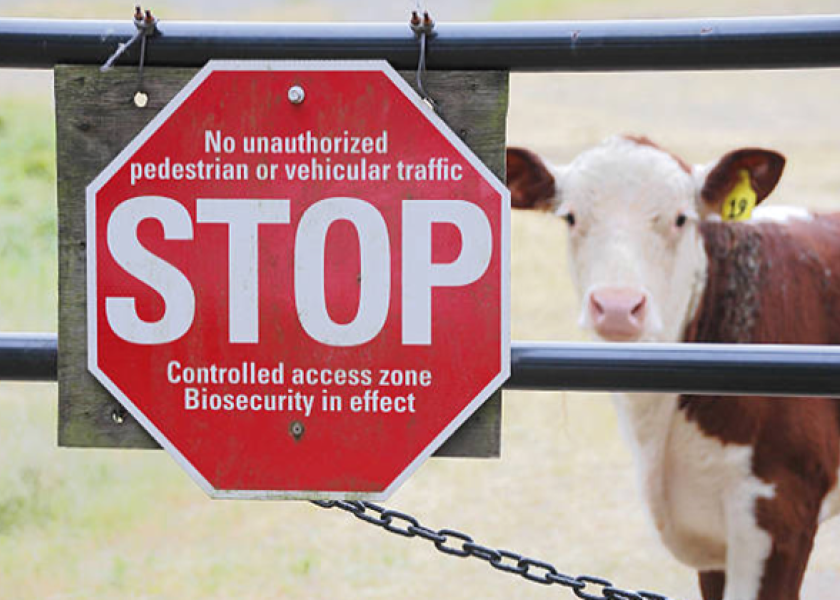The Work to Controlling BVDV Transmission Begins with Biosecurity

Dr. Paul Walz, professor of pathology at Auburn University, has tremendous knowledge of bovine viral diarrhea virus (BVDV) and how effective measures to controlling it starts with biosecurity, including the importance of simply taking the time to test.
As with most disease management programs, immunization is key. Working with your local diagnostic lab will offer the support and guidance necessary for success.
Bovine viral diarrhea virus continues to be a vexing problem for cow/calf producers. BVDV is spread in multiple ways and the risk control effort needs to have a multi-pronged approach.
According to Dr. Walz, there are three steps to controlling BVDV infections:
- Biosecurity
- Immunization
- Testing
Vaccinating is the act of giving the animal a vaccine, explained Dr. Walz, while immunization is when the animal has an immune response to the vaccine. He said ideally producers will give two doses of modified-live virus reproductive vaccine in replacement heifers before they are bred for the first time, with the last dose given approximately 30 days prior to breeding.
Annual revaccination with a modified-live virus vaccine, like Bovi-Shield Gold FP® 5 VL5, gives effective protection against BVDV infections. If a modified-live virus program in the mature cowherd doesn’t work for the operation, a killed BVDV reproductive vaccine, like CattleMaster Gold FP® 5, at pregnancy check time can also provide protection for the herd against BVDV infection.
Once producers have established a strong vaccination protocol for the cow herd, it is time to look beyond immunization to apply additional tools and management to reduce BVDV risks.
A cow persistently infected (PI) with BVDV will always have a calf that is persistently infected with BVDV. Dr. Walz points out the PI calf is a central figure in how BVDV maintains itself within a herd and how BVDV travels from herd to herd. But the risk for spreading BVDV extends throughout an operation, to equipment, visitors to the farm and fence-line contact among animals.
With so many avenues of BVDV transmission, the work to control the risk begins with biosecurity.
“We cannot rely on immunization to 100% prevent PI infections, nor can we look at our diagnostic test to pick up every single PI animal, so biosecurity is a really good way to reduce risk,” Dr. Walz said.
The main path for BVDV introduction to a herd is through new cattle. The “Trojan dam” — a highly immune cow that is a PI carrier in its reproductive tract and uterus — makes detection difficult, explained Dr. Walz. The cow would pass any test for BVDV, but it is, nonetheless, an infected animal. Producers who purchase pregnant animals, or are bringing them back from a heifer raiser, must contain them for biosecurity purposes to reduce BVDV spread.
“If at all possible, test for PI status of the newborn calves on the new cows rather than allowing those cows to calve within the general population of cows,” Dr. Walz said.
Dr. Walz shared some other essential components of effective biosecurity measures:
- Avoid bringing in new animals unless they’ve been tested.
- Isolate sick animals from healthy ones.
- Move dead animals away from the barn.
- Pay special attention to young animals.
- Practice general hygiene — soap, water and general disinfection.
- Monitor visitors and be aware of how they can transmit BVDV from farm to farm.
The importance of taking the time to test
“We have excellent tests available for BVDV,” Dr. Walz said. “We have better tests for BVDV than we have for a lot of our other diseases, including infectious bovine rhinotracheitis.”
Dr. Walz said testing the newborn calf is essentially testing the dam, and knowing those results can set in motion biosecurity measures and other steps. There are numerous ways to test, and working with a diagnostic laboratory can help produce the most useful results.
“Your diagnostic lab is a tremendous resource for testing, but also a tremendous resource for information on how to test and when to test,” Dr. Walz said.
For more information on biosecurity and taking steps to reduce the risk of BVDV, work with your local veterinarian, or visit FetalCalfProtection.com to learn about vaccine options from Zoetis to help protect the cow and unborn calf.







